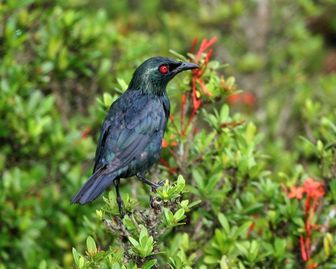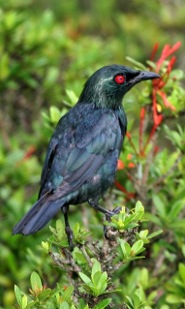Asian Glossy Starling
Asian Glossy Starling

Original source: Dr Yap Lip Kee
Author: Dr Yap Lip Kee
Asian Glossy Starling - the Community Bird
 The Asian Glossy Starling (Aplonis panayensis), also known as the Philippine Glossy Starling, is a bird in the Sturnidae or starling family. Both male and female birds have metallic, dark green feathers that can look black or purple. The eyes are bright red. Immature birds have an underside that is striped black and white, and upper feathers that are brownish-black. The bird is a medium sized, about 20 cm long. They have slim bodies and narrow wings, which help their flight, usually at tree-top level, to be swift and direct. The Starling family is considered one of the noisiest families of birds. The Asian Glossy Starling has a call like a short whistle when perched, and ringing or piping call when in flight. Like other birds in the Sturnidae family, they can mimic other sounds.
The Asian Glossy Starling (Aplonis panayensis), also known as the Philippine Glossy Starling, is a bird in the Sturnidae or starling family. Both male and female birds have metallic, dark green feathers that can look black or purple. The eyes are bright red. Immature birds have an underside that is striped black and white, and upper feathers that are brownish-black. The bird is a medium sized, about 20 cm long. They have slim bodies and narrow wings, which help their flight, usually at tree-top level, to be swift and direct. The Starling family is considered one of the noisiest families of birds. The Asian Glossy Starling has a call like a short whistle when perched, and ringing or piping call when in flight. Like other birds in the Sturnidae family, they can mimic other sounds.
These birds are community oriented, and congregate in groups of around 20. The flock will roost in a tree together, feed together, and fly together. Before landing in a roosting tree, the flock will perform an intricate dance over the tree, flying in symmetrical patterns. The birds set up their nests near the rest of the flock, and brood all year long, mostly from March to June. They build nests in sheltered, elevated places, such as holes in trees or under eaves of man-made structures. Nests vary in intricacy from a little grass added to a hole, to detailed nests made from grass and paper. The female lays three dark blue eggs with brown spots.
Their diet consists predominantly of soft fruits, such as mango, papaya, and banana, as well as berries, figs, and insects. They prefer perching in trees, and rarely land on the ground. Only fallen fruit tempt them to the ground, and then they hop awkwardly.
The Asian Glossy Starling lives in India, Thailand, the Philippines, Indonesia, and the surrounding countries. The preferred habitat of this bird is tropical or subtropical moist lowland or mangrove forests. These birds do not migrate. A large population of the Asian Glossy Starling lives in cities, making nests in abandoned buildings and trees. This species has a endangered species status of least concern, as it has adapted well to human development. On fruit plantations, it is even thought of as an invasive bird.
Picture of the Asian glossy starling by Dr Yap Lip Kee, licensed under Creative Commons Attribution-Share Alike 2.0 Generic license.
The Asian Glossy Starling is classified as Least Concern. Does not qualify for a more at risk category. Widespread and abundant taxa are included in this category.
Family : Sturnidae
Genus : Aplonis
Species : panayensis
Authority : (Scopoli, 1783)

